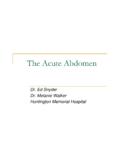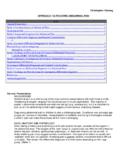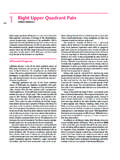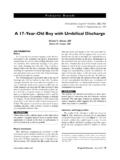Transcription of Letter to the Editor - Chris Barton
1 ELSEVIER The Journal of Emergency Medicine, Vol 14, No 2, pp 245-246, 1996 Coovright D 1996 Elsevier Science Inc. PrkkdY in the USA. All rights reserved 0736-4679/96 $ + .OO Letter to the Editor q The GI Cocktail in the Evaluation of Chest pain in the Emergency Department The following case illustrates a recurring problem in the emergency department evaluation of chest pain . The chal- lenge in evaluating chest pain is to determine which pa- tients have a life-threatening condition and which do not. One of the more difficult problems is to separate chest pain due to esophageal disease from that caused by myo- cardial ischemia.
2 Both are common and both can respond to nitrates and calcium channel blockers; however, one is an emergency and the other generally is not. Unfortu- nately, some of the strategies used to determine the cause of chest pain are inappropriate based on the existing literature. The use of a GI Cocktail in the emergency department evaluation of chest pain is such an inappropri- ate practice. I present below a case of acute myocardial infarction with a prompt and complete response of chest pain to a GI Cocktail. Following the case, I have reviewed the sparse and inconclusive literature on this diagnostic test.
3 A 46-year-old white male with no prior history of heart disease presented to the emergency department complaining of 10 and a half hours of substemal chest pain with nausea and dizziness. The pain was initially described as like a weight, and there was associated left arm numbness and dyspnea. He was a smoker, but there was no family history of early cardiac disease, nor a history of hypertension, diabetes mellitus, or hypercho- lesterolemia. The patient looked much more comfortable than expected for his complaints and had a benign exami- nation. The patient described years of epigastric pain with reflux characteristics and recent black stool.
4 The patient also recanted much of his earlier history and indi- cated his current pain was epigastric. He also said it was the same thing he had been having for years and that he thought it was his stomach. A GI Cocktail was administered (30 cc Mylanta II, 10 cc Donnatal Elixir, and 5 cc Viscous Lidocaine 2%), and the patient had prompt and complete relief of his discomfort and elimina- tion of all associated symptoms. An EKG had also been performed during this time and was felt to have no find- ings of acute ischemia and to be unchanged from one done 2 months prior (in retrospect, there were minor changes with a new T-wave inversion and mm Q- wave in lead III).
5 Because of the patient s initial worrisome history, blood work had also been sent, including a CPK. This was reported as 988 Units/L (normal 25-232 U/L) with a CPK-MB of rig/ml (normal ng/ ml). The patient was treated with aspirin, nitrates, and heparinization, and did well with a peak CPK of 1472 U/L. He was transferred to a referral hospital the next day for cardiac catheterization, which showed a recent 100% occlusion of the right coronary artery, which was successfully opened with angioplasty. This case illustrates the central importance of his- tory in deciding the initial management of chest pain patients ( 1,2).
6 Second, the case illustrates the difficulty of emergency department laboratory confirmation or refutation of a clinical suspicion of myocardial isch- emia. The emergency department electrocardiogram is not always diagnostic and is often misinterpreted (3). Emergency department determinations of CPK and CPK-MB have not proved to be as useful as was hoped and frequently are not available immediately (4). Fi- nally, the case illustrates the inappropriateness of the GI Cocktail as a diagnostic tool in the emergency evaluation of chest pain . Distinguishing ischemic from esophageal chest pain is difficult.
7 They can share characteristics such as dys- pepsia and response to nitrates. The sympathetic pain fibers that serve both converge, possibly explaining the difficulty of separating esophageal and cardiac pain . Published reviews on this topic suggest the use of the Bernstein Intraesophageal Acid Drip Test, esophageal manometry, and other studies not usually performed in the emergency department (5,6). The frequency with which the GI Cocktail is used in the evaluation of Guidelines for Letters-Letters will appear at the discretion of the Editor as space permits and may be subjected to 245 246 The Journal of Emergency Medicine - chest pain in the emergency department is unknown; however, its use for this purpose is common in the author s experience, and such use has been promoted in national journals (7,B).
8 A Medline search using the terms GI Cocktail, Ant- acids, Local Anesthetics, Esophageal Diseases, and Chest pain , Angina Pectoris, or Myocardial Infarction located only two studies on the predictive characteris- tics of the GI Cocktail. An observational case series with an unspecified number of patients for this parame- ter stated that antacids relieved chest pain due to esoph- agitis in 39% of cases and relieved cardiac chest pain in 7%, using esophagoscopy and EKG criteria for diag- nosis (9). The second study involved an uncontrolled opportunity sample of 60 patients (whose characteris- tics were not stated) presenting to an emergency de- partment with chest pain and no EKG evidence of myocardial infarction ( 10).
9 It found that no patient with complete or almost complete response to a mix of Viscous Lidocaine and Maalox or Mylanta had a myocardial infarction by unstated criteria. The author recognized his study was preliminary and that larger and better trials were needed to validate his findings. Finally, others have also reported cases of complete relief of myocardial pain by the GI Cocktail ( 1 1 ). Therefore, the available literature consists of two weak studies with conflicting results and case reports docu- menting the failure of this test to accurately diagnose patients. Using a GI Cocktail in the emergency evaluation of chest pain is a diagnostic test for which the sensitiv- ity and specificity are unknown.
10 The case above illus- trates how unreliable and potentially dangerous it can be. At the present time, the response of a patient with chest pain to a GI Cocktail has no place in the decision of whether to treat a patient s pain as cardiac, possibly cardiac, or noncardiac. Mark W. Dickinson, MPH, MD Fort Defiance Indian Hospital Fort Defiance, Arizona SSDI 0736-4679(95)02101-9 REFERENCES 1. 2. 3. 4. 5. Aase 0, Jonsbu J, Liestol K, et al. Decision support by computer analysis of selected case history variables in the emergency room among patients with acute chest pain . Eur Heart J.






